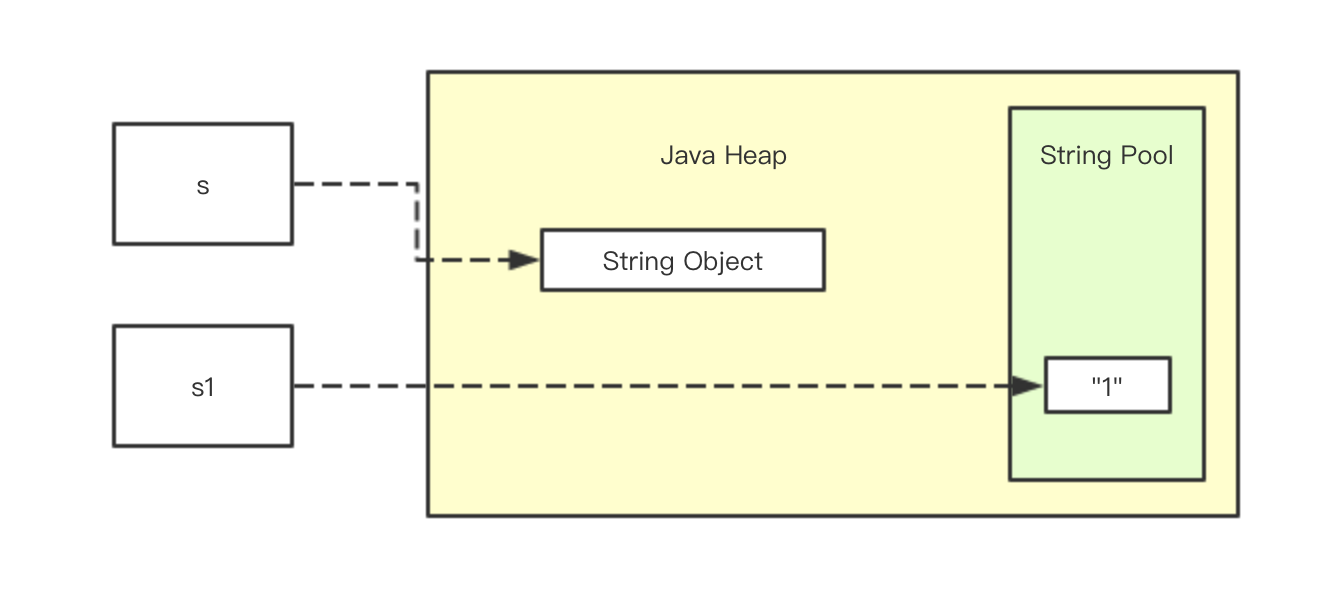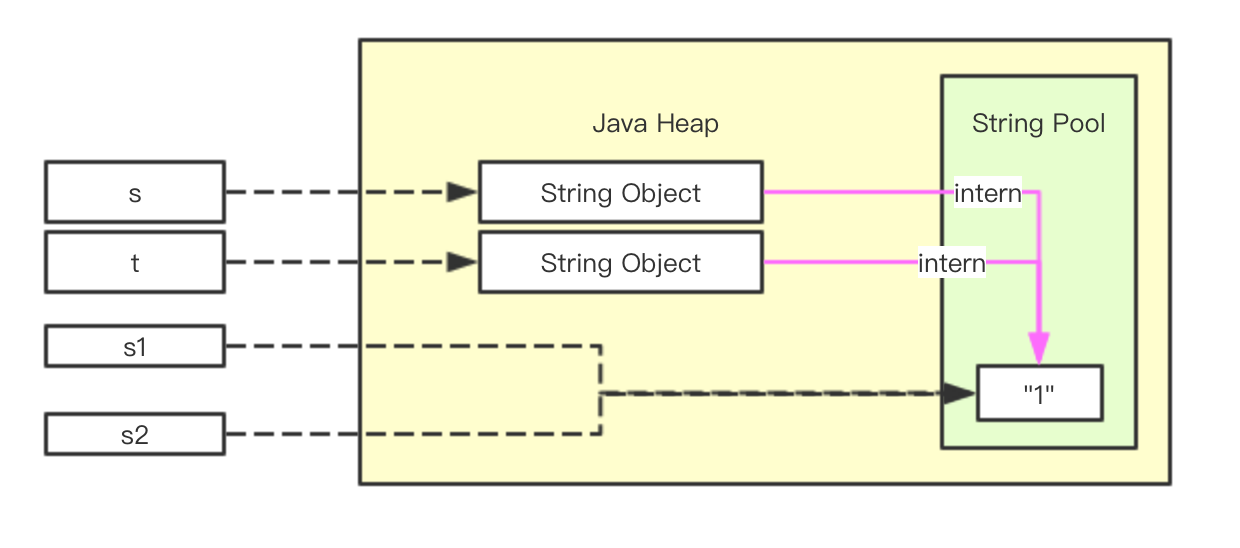String数据在堆中怎么存储 String.intern()
String.intern()使用总结
First Blood
先看下面的代码:
String s = new String("1");
String s1 = s.intern();
System.out.println(s == s1);
打印结果为:
false
对于new String("1"),会生成两个对象,一个是String类型对象,它将存储在Java Heap中,另一个是字符串常量对象"1",它将存储在字符串常量池中。
s.intern()方法首先会去字符串常量池中查找是否存在字符串常量对象"1",如果存在则返回该对象的地址,如果不存在则在字符串常量池中生成为一个"1"字符串常量对象,并返回该对象的地址。
如下图:

变量s指向的是Stirng类型对象,变量s1指向的是"1"字符串常量对象,所以s == s1结果为false。
Double kill
在上面的基础上我们再定义一个s2如下:
String s = new String("1");
String s1 = s.intern();
String s2 = "1";
System.out.println(s == s1);
System.out.println(s1 == s2); // true
s1 == s2为true,表示变量s2是直接指向的字符串常量,如下图:

Triple kill
在上面的基础上我们再定义一个t如下:
String s = new String("1");
String t = new String("1");
String s1 = s.intern();
String s2 = "1";
System.out.println(s == s1);
System.out.println(s1 == s2);
System.out.println(s == t); // false
System.out.println(s.intern() == t.intern()); // true
s == t为false,这个很明显,变量s和变量t指向的是不同的两个String类型的对象。
s.intern() == t.intern()为true,因为intern方法返回的是字符串常量池中的同一个"1"对象,所以为true。

Ultra kill
在上面的基础上我们再定义一个x和s3如下:
String s = new String("1");
String t = new String("1");
String x = new String("1") + new String("1");
String s1 = s.intern();
String s2 = "1";
String s3 = "11";
System.out.println(s == s1);
System.out.println(s1 == s2);
System.out.println(s == t);
System.out.println(s.intern() == t.intern());
System.out.println(x == s3); // fasle
System.out.println(x.intern() == s3.intern()); // true
变量x为两个String类型的对象相加,因为x != s3,所以x肯定不是指向的字符串常量,实际上x就是一个String类型的对象,调用x.intern()方法将返回"11"对应的字符串常量,所以x.intern() == s3.intern()为true。
Rampage
将上面的代码简化并添加几个变量如下:
String x = new String("1") + new String("1");
String x1 = new String("1") + "1";
String x2 = "1" + "1";
String s3 = "11";
System.out.println(x == s3); // false
System.out.println(x1 == s3); // false
System.out.println(x2 == s3); // true
x == s3为false表示x指向String类型对象,s3指向字符串常量;
x1 == s3为false表示x1指向String类型对象,s3指向字符串常量;
x2 == s3为true表示x2指向字符串常量,s3指向字符串常量;
所以我们可以看到new String("1") + "1"返回的String类型的对象。
总结
现在我们知道intern方法就是将字符串保存到常量池中,在保存字符串到常量池的过程中会先查看常量池中是否已经存在相等的字符串,如果存在则直接使用该字符串。
所以我们在写业务代码的时候,应该尽量使用字符串常量池中的字符串,比如使用String s = "1";比使用new String("1");更节省内存。我们也可以使用String s = 一个String类型的对象.intern();方法来间接的使用字符串常量,这种做法通常用在你接收到一个String类型的对象而又想节省内存的情况下,当然你完全可以String s = 一个String类型的对象;但是这么用可能会因为变量s的引用而影响String类型对象的垃圾回收。所以我们可以使用intern方法进行优化,但是需要注意的是intern能节省内存,但是会影响运行速度,因为该方法需要去常量池中查询是否存在某字符串。
参考:https://tech.meituan.com/2014/03/06/in-depth-understanding-string-intern.html





【推荐】国内首个AI IDE,深度理解中文开发场景,立即下载体验Trae
【推荐】编程新体验,更懂你的AI,立即体验豆包MarsCode编程助手
【推荐】抖音旗下AI助手豆包,你的智能百科全书,全免费不限次数
【推荐】轻量又高性能的 SSH 工具 IShell:AI 加持,快人一步
· 基于Microsoft.Extensions.AI核心库实现RAG应用
· Linux系列:如何用heaptrack跟踪.NET程序的非托管内存泄露
· 开发者必知的日志记录最佳实践
· SQL Server 2025 AI相关能力初探
· Linux系列:如何用 C#调用 C方法造成内存泄露
· 无需6万激活码!GitHub神秘组织3小时极速复刻Manus,手把手教你使用OpenManus搭建本
· Manus爆火,是硬核还是营销?
· 终于写完轮子一部分:tcp代理 了,记录一下
· 别再用vector<bool>了!Google高级工程师:这可能是STL最大的设计失误
· 单元测试从入门到精通